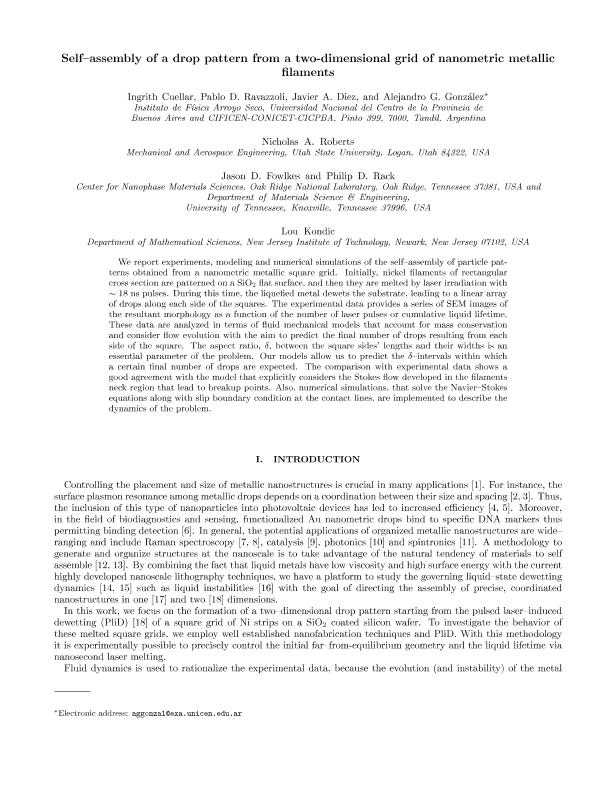Artículo
Self-assembly of a drop pattern from a two-dimensional grid of nanometric metallic filaments
Cuellar Berrio, Ingrith Paola ; Ravazzoli, Pablo Damián
; Ravazzoli, Pablo Damián ; Diez, Javier Alberto
; Diez, Javier Alberto ; Gonzalez, Alejandro Guillermo
; Gonzalez, Alejandro Guillermo ; Roberts, Nicholas A.; Fowlkes, Jason D.; Rack, Philip D.; Kondic, Lou
; Roberts, Nicholas A.; Fowlkes, Jason D.; Rack, Philip D.; Kondic, Lou
 ; Ravazzoli, Pablo Damián
; Ravazzoli, Pablo Damián ; Diez, Javier Alberto
; Diez, Javier Alberto ; Gonzalez, Alejandro Guillermo
; Gonzalez, Alejandro Guillermo ; Roberts, Nicholas A.; Fowlkes, Jason D.; Rack, Philip D.; Kondic, Lou
; Roberts, Nicholas A.; Fowlkes, Jason D.; Rack, Philip D.; Kondic, Lou
Fecha de publicación:
04/10/2018
Editorial:
American Physical Society
Revista:
Physical Review E
ISSN:
2470-0045
e-ISSN:
2470-0053
Idioma:
Inglés
Tipo de recurso:
Artículo publicado
Clasificación temática:
Resumen
We report experiments, modeling, and numerical simulations of the self-assembly of particle patterns obtained from a nanometric metallic square grid. Initially, nickel filaments of rectangular cross section are patterned on a SiO2 flat surface, and then they are melted by laser irradiation with ∼18-ns pulses. During this time, the liquefied metal dewets the substrate, leading to a linear array of drops along each side of the squares. The experimental data provide a series of SEM images of the resultant morphology as a function of the number of laser pulses or cumulative liquid lifetime. These data are analyzed in terms of fluid mechanical models that account for mass conservation and consider flow evolution with the aim to predict the final number of drops resulting from each side of the square. The aspect ratio, δ, between the square sides' lengths and their widths is an essential parameter of the problem. Our models allow us to predict the δ intervals within which a certain final number of drops are expected. The comparison with experimental data shows a good agreement with the model that explicitly considers the Stokes flow developed in the filaments neck region that lead to breakup points. Also, numerical simulations that solve the Navier-Stokes equations along with slip boundary condition at the contact lines are implemented to describe the dynamics of the problem.
Palabras clave:
metals
,
dewetting
,
drops
,
nanofluidics
Archivos asociados
Licencia
Identificadores
Colecciones
Articulos(CIFICEN)
Articulos de CENTRO DE INV. EN FISICA E INGENIERIA DEL CENTRO DE LA PCIA. DE BS. AS.
Articulos de CENTRO DE INV. EN FISICA E INGENIERIA DEL CENTRO DE LA PCIA. DE BS. AS.
Citación
Cuellar Berrio, Ingrith Paola; Ravazzoli, Pablo Damián; Diez, Javier Alberto; Gonzalez, Alejandro Guillermo; Roberts, Nicholas A.; et al.; Self-assembly of a drop pattern from a two-dimensional grid of nanometric metallic filaments; American Physical Society; Physical Review E; 98; 4; 4-10-2018; 1-12
Compartir
Altmétricas



